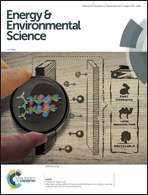Highly selective gas separation membrane using in situ amorphised metal–organic frameworks†
Abstract
Conventional carbon dioxide (CO2) separation in the petrochemical industry via cryogenic distillation is energy intensive and environmentally unfriendly. Alternatively, polymer membrane-based separations are of significant interest owing to low production cost, low-energy consumption and ease of upscaling. However, the implementation of commercial polymeric membranes is limited by their permeability and selectivity trade-off and the insufficient thermal and chemical stability. Herein, a novel type of amorphous mixed matrix membrane (MMM) able to separate CO2/CH4 mixtures with the highest selectivities ever reported for MOF based MMMs is presented. The MMM consists of an amorphised metal–organic framework (MOF) dispersed in an oxidatively cross-linked matrix achieved by fine tuning of the thermal treatment temperature in air up to 350 °C which drastically boosts the separation properties of the MMM. Thanks to the protection of the surrounding polymer, full oxidation of this MOF (i.e. ZIF-8) is prevented, and amorphisation of the MOF is realized instead, thus in situ creating a molecular sieve network. In addition, the treatment also improves the filler-polymer adhesion and induces an oxidative cross-linking of the polyimide matrix, resulting in MMMs with increased stability or plasticization resistance at high pressure up to 40 bar, marking a new milestone as new molecular sieve MOF MMMs for challenging natural gas purification applications. A new field for the use of amorphised MOFs and a variety of separation opportunities for such MMMs are thus opened.



 Please wait while we load your content...
Please wait while we load your content...